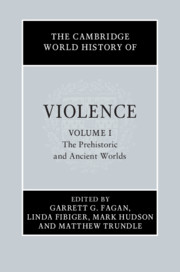Book contents
- The Cambridge World History of Violence
- The Cambridge History of Violence
- The Cambridge World History of Violence
- Copyright page
- Contents
- Figures
- Maps
- Contributors to Volume i
- General Introduction: Violence in World History
- Introduction to Volume I
- Part I The Origins of Conflict
- Part II Prehistoric and Ancient Warfare
- Part III Intimate and Collective Violence
- 14 Early Massacres: Mass Violence in Neolithic Europe
- 15 Gendered Violence in Iron Age and Roman Britain
- 16 Violence in Ancient Egyptian Society
- 17 Violence and the Mutilated Body in Achaemenid Iran
- 18 ‘Knocking Her Teeth out with a Stone’: Violence against Women in Ancient Greece
- 19 Gang Violence in the Late Roman Republic
- 20 Violence in Early Chinese History
- Part IV Religion, Ritual and Violence
- Part V Violence, Crime and the State
- Part VI Representations and Constructions of Violence
- Index
- References
17 - Violence and the Mutilated Body in Achaemenid Iran
from Part III - Intimate and Collective Violence
Published online by Cambridge University Press: 13 March 2020
- The Cambridge World History of Violence
- The Cambridge History of Violence
- The Cambridge World History of Violence
- Copyright page
- Contents
- Figures
- Maps
- Contributors to Volume i
- General Introduction: Violence in World History
- Introduction to Volume I
- Part I The Origins of Conflict
- Part II Prehistoric and Ancient Warfare
- Part III Intimate and Collective Violence
- 14 Early Massacres: Mass Violence in Neolithic Europe
- 15 Gendered Violence in Iron Age and Roman Britain
- 16 Violence in Ancient Egyptian Society
- 17 Violence and the Mutilated Body in Achaemenid Iran
- 18 ‘Knocking Her Teeth out with a Stone’: Violence against Women in Ancient Greece
- 19 Gang Violence in the Late Roman Republic
- 20 Violence in Early Chinese History
- Part IV Religion, Ritual and Violence
- Part V Violence, Crime and the State
- Part VI Representations and Constructions of Violence
- Index
- References
Summary
Little thought per se has been given to women as agents of violence in antiquity, let alone to the role of the royal harem as the site of revenge-fuelled violence and murder. This chapter addresses this gap by exploring how royal women in the Persian Empire could be instruments of violence. While acknowledging the Greek obsession with this topos, it goes beyond the Western preoccupation with the harem as a site of Oriental decadence and attempts to put stories of women’s violence against women into its ancient Near Eastern context. It explores the mutilation of the body and is particularly focused on the Herodotean tale (which has genuine Persian roots) of the revenge mutilations of Amestris, wife of Xerxes I.
- Type
- Chapter
- Information
- The Cambridge World History of Violence , pp. 360 - 379Publisher: Cambridge University PressPrint publication year: 2020

